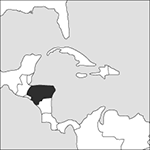
Source: MAPS IN MINUTES™ © RH Publications (1997)
Capital:
Tegucigalpa
Area:
112,090 sq km (43,278 sq miles)
Population:
8,448,465 (2013 est)
Currency:
1 Honduran lempira = 100 centavos
Religions:
Roman Catholic 97.0%; Protestant 3.0%
Ethnic Groups:
Mestizo 90.0%; Amerindian 7.0%; Black 2.0%; White 1.0%
Languages:
Spanish (official); minority languages
International Organizations:
UN; OAS; Non-Aligned Movement; WTO
A country in Central America, bounded on the north and west by Guatemala and El Salvador and on the south by Nicaragua.
Physical
Honduras has a long, north-east coast on the Caribbean Sea and a short, south-west coast on the Pacific Ocean. Most of it is mountainous and heavily forested, and the soil is generally poor and acid.
Economy
Honduras was formerly dependent on banana and coffee exports, but clothing and wiring harnesses for vehicles are now also important. Other crops include citrus fruit and cereals; other industries include sugar and wood products. Honduras is a very poor country with high levels of inequality. Over half the population live in poverty.
History
The native inhabitants of Honduras are mestizo Indians. One of the lieutenants of Hermando Cortés, Francisco de las Casas, founded the first settlement, the port of Trujillo, in 1523. Honduras was attached administratively to the captaincy-general of Guatemala throughout the Spanish colonial period.
When independence came in 1821 it briefly became part of the empire of Agustin de Iturbide before joining the United Provinces of Central America (1825–38). Separate independent status dates from 1838, when the union broke up. An uninterrupted succession of caudillos dominated the remainder of the 19th century. Improvement in the political process came slowly in the 20th century. Military dictators continued to be more prominent than civilian presidents, but the election in 1957 of Ramón Villeda Morales gave hope for the future. This optimism proved premature as the Honduran army overthrew him before he could implement the reform programme he had pushed through the congress. Military entrenchment was further solidified as Honduras fought a border war with El Salvador in 1969. In 1982 a new, US-backed, constitution aimed to increase democratic activity. As a condition for US support, however, the country provided a base for ‘Contra’ rebels from Nicaragua. In 1985 a new President, José Azcona (1985–90) threatened to stop ‘Contra’ activity, as well as to reduce the power of the military. Honduras, however, remained economically dependent upon the USA, and in 1989 Rafael Callejas was elected President with US support. He faced economic turbulence, left-wing guerrilla activity, and security forces almost totally out of control. Despite assistance loans from the IMF and the World Bank, the government’s economic structural adjustment plan, launched in 1990, provoked sustained hostility, causing social unrest and political instability in 1992. In September the long-standing border dispute with El Salvador was resolved by an International Court of Justice ruling. In the presidential elections of November 1993 Carlos Roberto Reina, who opposed Callejas, was elected. The declared priorities of the new government were the economy and the reduction of the military’s role in politics. In 1998 the country was devastated by Hurricane Mitch. Reina was followed as President by Carlos Roberto Flores (1998–2002) and Ricardo Maduro Joest (2002–06). In 2009 Maduro’s successor, José Manuel Zelaya Rosales, precipitated a constitutional crisis that culminated in his overthrow by a military coup. Following elections Porfirio Lobo Sosa became President in 2010. He was succeeded in 2014 by Juan Orlando Hernández. Following a disputed election in November 2017, Hernández was re-elected, amid calls for fresh elections.
- running yield
- run-off
- run-off triangle
- runs test
- run time
- runtime error
- run-time system
- run-time verification
- Rupelian
- Rupert, Prince (1619–82)
- rupes
- rupture
- rupture disc
- rural
- rural depopulation
- rural geography
- rurality
- rural–urban continuum
- rural–urban fringe
- rush
- Rushton, John Henry (1905–85)
- Rushton turbine
- Rushton, William Albert Hugh
- Ruska, Ernst August Friedrich
- Rusophycus